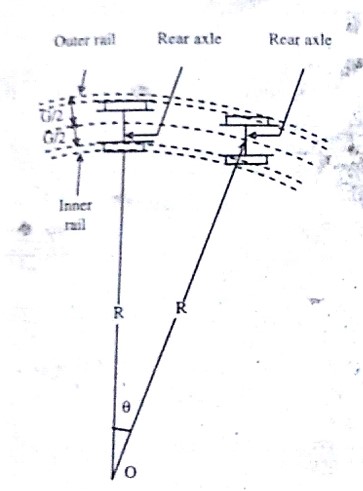Coning of wheels is an interesting topic in railway engineering. In this blog, we will see the theory of coming of rail wheels, starting from what is coning of wheels.
What is coning of wheels?

Let’s see what is coning of wheels step by step.
- The space between the inner borders of wheel rims is by and large kept less than the measurement of the track.
- This results in a gap between the wheel rims and running ends of the rail which is approximately equal to 1cm. (2/8 on both sides).
- More often than not, the tread of wheels is perfectly the dead centre of the beginning of the rail, since the wheel is chamfered to keep it in this middle position involuntarily.
- Thus, in coning of wheel the tread or rim of wheels of railway vehicles is made in the shape of a cone with the slope of about 1 in 20.
- It maintains the vehicle in the central position with respect to the track.
- On straight track, portions of wheels running on track have the same diameter.
- While on the curved path, the outer wheel has to cover a larger distance than the inner wheel. Thus, the portions of wheels running on track have different diameters which help in the smooth running of wheels.
Theory of coning of wheels

- We have seen what is coning of _wheel through some easy read bullet points. Let me do the same to learn the theory behind coning of rail wheels.
- On a railway level track, the moment the hinge locomotes towards one rail, the wheel tread width above the rail steps-u but reduces over the other rail.
- This forbids the auxiliary movement and hinge pulls back to its original position.
- This is possible only if the diameters on both rails are equal and the pressure on both rails is also equal.
- On a coiled path, because of the rigidity of the wheel bottom, either of the wheels has to slip by a measure equal to the differentiation of length.
- Or else, the axle has to move outward a bit so that a tread with longer diameter is formed over the outer rail where, as a slighter diameter tread is formed over the inner rail.
Also read: Applications of Intelligent transportation system- everything you want to know
Calculation of coning of wheels

If the diameter of the tread on both the rails is equal, then
Slip=α (R2-R1),
The outer radius, R2=R+C/2
Inner radius, R1= R-G/2
G= Gauge
α= Angle at centre in radians
Therefore, slip= alpha X G
α 0 = Angle center in degrees about 1 degree
α 0 Slip= 0.029 (roughly for 1 degree of central angle)
- Therefore, the slip is about 0.029m per degree of the central angle.
- Chamfering of wheels on bends is not useful as the principal axle if owing to centrifugal force proceeds towards the outward rail the back axle will precede towards the inside rail and the complete benefit of coning wheels cannot be availed.
- Put differently, there will be no free sidelong movement of wheels.
- This results in the disadvantages of the outer rail will have more pressure while the inner rail will have lesser pressure.
- Owing to the central strength, the parallel components incline to turn the rail out and the gauge has broadening tendency.
- Due to this condition if the voids sleepers have no base plate beneath the edge of the rail they will be damages. In order to get rid of or minimize the supra mentioned faults “angling of rails” is done.
- When the rails are tilted then the base plate or sleeper is not placed horizontally. It is laid at a slope of 1 in 20 towards the inner side.
Advantages
- Smooth riding- help vehicle to negotiate curves smoothly
- Reduces wear and tear of wheel flanges. Damage is caused because of the friction action of rims with inner faces of the rail top.
- It gives an option of lateral drift of the hinge with its wheels
- It prevents, to some extent, the slipping of the wheels
We have seen the advantages. Let’s see the disadvantages of coning of wheels now.
Disadvantages
- The pressure on the horizontal component of force near the inner edge of outer rail has a tendency to wear the rail quickly
- The horizontal component has to turn the rail outwards and hence the gauges may be widened.
- If no base plates are provided, sleepers under the outer edge of the rail may be damaged
Also read: Intelligent transportation system: A comprehensive approach to its components


One thought on “Coning of wheels- What is coning of wheels?”